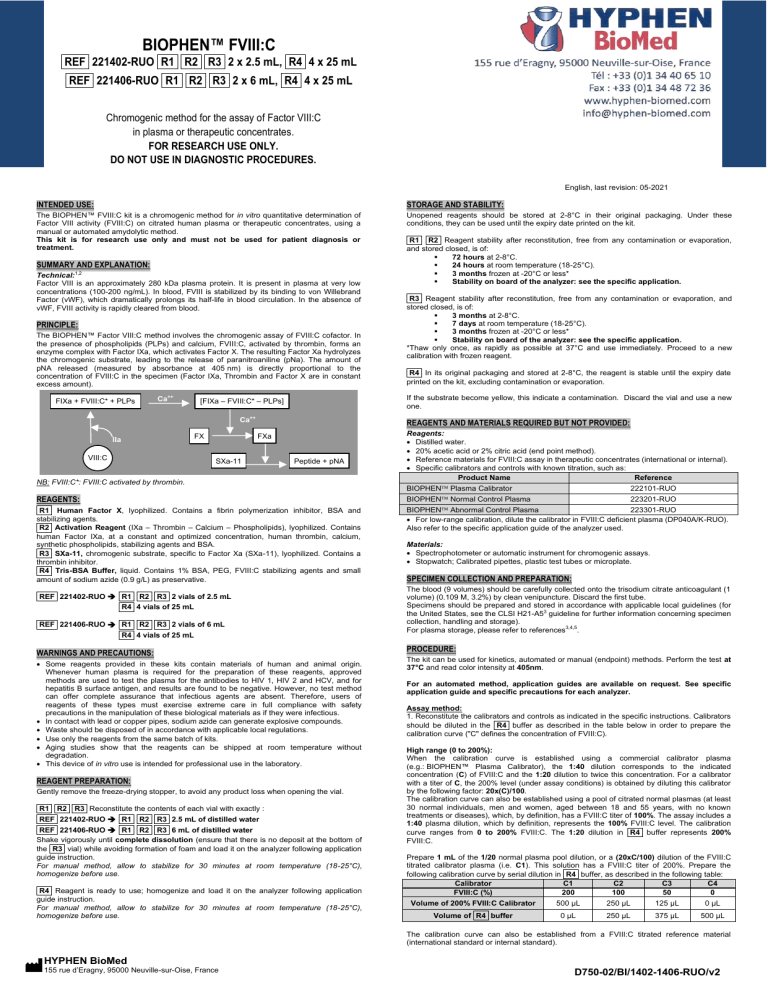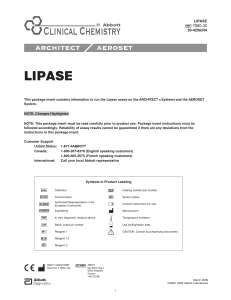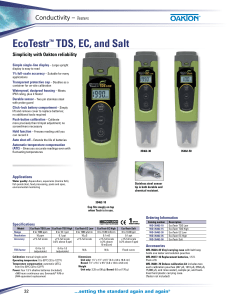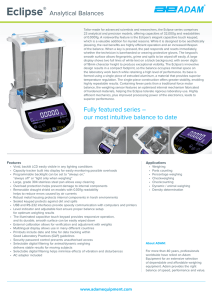
BIOPHEN™ FVIII:C REF 221402-RUO R1 R2 R3 2 x 2.5 mL, R4 4 x 25 mL REF 221406-RUO R1 R2 R3 2 x 6 mL, R4 4 x 25 mL Chromogenic method for the assay of Factor VIII:C in plasma or therapeutic concentrates. FOR RESEARCH USE ONLY. DO NOT USE IN DIAGNOSTIC PROCEDURES. English, last revision: 05-2021 INTENDED USE: STORAGE AND STABILITY: The BIOPHEN™ FVIII:C kit is a chromogenic method for in vitro quantitative determination of Factor VIII activity (FVIII:C) on citrated human plasma or therapeutic concentrates, using a manual or automated amydolytic method. This kit is for research use only and must not be used for patient diagnosis or treatment. Unopened reagents should be stored at 2-8°C in their original packaging. Under these conditions, they can be used until the expiry date printed on the kit. SUMMARY AND EXPLANATION: Technical:1,2 Factor VIII is an approximately 280 kDa plasma protein. It is present in plasma at very low concentrations (100-200 ng/mL). In blood, FVIII is stabilized by its binding to von Willebrand Factor (vWF), which dramatically prolongs its half-life in blood circulation. In the absence of vWF, FVIII activity is rapidly cleared from blood. PRINCIPLE: The BIOPHEN™ Factor VIII:C method involves the chromogenic assay of FVIII:C cofactor. In the presence of phospholipids (PLPs) and calcium, FVIII:C, activated by thrombin, forms an enzyme complex with Factor IXa, which activates Factor X. The resulting Factor Xa hydrolyzes the chromogenic substrate, leading to the release of paranitroaniline (pNa). The amount of pNA released (measured by absorbance at 405 nm) is directly proportional to the concentration of FVIII:C in the specimen (Factor IXa, Thrombin and Factor X are in constant excess amount). FIXa + FVIII:C* + PLPs Ca++ VIII:C FX R3 Reagent stability after reconstitution, free from any contamination or evaporation, and stored closed, is of: ▪ 3 months at 2-8°C. ▪ 7 days at room temperature (18-25°C). ▪ 3 months frozen at -20°C or less* ▪ Stability on board of the analyzer: see the specific application. *Thaw only once, as rapidly as possible at 37°C and use immediately. Proceed to a new calibration with frozen reagent. R4 In its original packaging and stored at 2-8°C, the reagent is stable until the expiry date printed on the kit, excluding contamination or evaporation. If the substrate become yellow, this indicate a contamination. Discard the vial and use a new one. [FIXa – FVIII:C* – PLPs] Ca++ IIa R1 R2 Reagent stability after reconstitution, free from any contamination or evaporation, and stored closed, is of: ▪ 72 hours at 2-8°C. ▪ 24 hours at room temperature (18-25°C). ▪ 3 months frozen at -20°C or less* ▪ Stability on board of the analyzer: see the specific application. REAGENTS AND MATERIALS REQUIRED BUT NOT PROVIDED: FXa SXa-11 Peptide + pNA NB: FVIII:C*: FVIII:C activated by thrombin. REAGENTS: R1 Human Factor X, lyophilized. Contains a fibrin polymerization inhibitor, BSA and stabilizing agents. R2 Activation Reagent (IXa – Thrombin – Calcium – Phospholipids), lyophilized. Contains human Factor IXa, at a constant and optimized concentration, human thrombin, calcium, synthetic phospholipids, stabilizing agents and BSA. R3 SXa-11, chromogenic substrate, specific to Factor Xa (SXa-11), lyophilized. Contains a thrombin inhibitor. R4 Tris-BSA Buffer, liquid. Contains 1% BSA, PEG, FVIII:C stabilizing agents and small amount of sodium azide (0.9 g/L) as preservative. REF 221402-RUO ➔ R1 R2 R3 2 vials of 2.5 mL R4 4 vials of 25 mL REF 221406-RUO ➔ R1 R2 R3 2 vials of 6 mL R4 4 vials of 25 mL WARNINGS AND PRECAUTIONS: • Some reagents provided in these kits contain materials of human and animal origin. Whenever human plasma is required for the preparation of these reagents, approved methods are used to test the plasma for the antibodies to HIV 1, HIV 2 and HCV, and for hepatitis B surface antigen, and results are found to be negative. However, no test method can offer complete assurance that infectious agents are absent. Therefore, users of reagents of these types must exercise extreme care in full compliance with safety precautions in the manipulation of these biological materials as if they were infectious. • In contact with lead or copper pipes, sodium azide can generate explosive compounds. • Waste should be disposed of in accordance with applicable local regulations. • Use only the reagents from the same batch of kits. • Aging studies show that the reagents can be shipped at room temperature without degradation. • This device of in vitro use is intended for professional use in the laboratory. REAGENT PREPARATION: Gently remove the freeze-drying stopper, to avoid any product loss when opening the vial. R1 R2 R3 Reconstitute the contents of each vial with exactly : REF 221402-RUO ➔ R1 R2 R3 2.5 mL of distilled water REF 221406-RUO ➔ R1 R2 R3 6 mL of distilled water Shake vigorously until complete dissolution (ensure that there is no deposit at the bottom of the R3 vial) while avoiding formation of foam and load it on the analyzer following application guide instruction. For manual method, allow to stabilize for 30 minutes at room temperature (18-25°C), homogenize before use. R4 Reagent is ready to use; homogenize and load it on the analyzer following application guide instruction. For manual method, allow to stabilize for 30 minutes at room temperature (18-25°C), homogenize before use. Reagents: • Distilled water. • 20% acetic acid or 2% citric acid (end point method). • Reference materials for FVIII:C assay in therapeutic concentrates (international or internal). • Specific calibrators and controls with known titration, such as: Product Name Reference 222101-RUO BIOPHEN Plasma Calibrator 223201-RUO BIOPHEN Normal Control Plasma 223301-RUO BIOPHEN Abnormal Control Plasma • For low-range calibration, dilute the calibrator in FVIII:C deficient plasma (DP040A/K-RUO). Also refer to the specific application guide of the analyzer used. Materials: • Spectrophotometer or automatic instrument for chromogenic assays. • Stopwatch; Calibrated pipettes, plastic test tubes or microplate. SPECIMEN COLLECTION AND PREPARATION: The blood (9 volumes) should be carefully collected onto the trisodium citrate anticoagulant (1 volume) (0.109 M, 3.2%) by clean venipuncture. Discard the first tube. Specimens should be prepared and stored in accordance with applicable local guidelines (for the United States, see the CLSI H21-A53 guideline for further information concerning specimen collection, handling and storage). For plasma storage, please refer to references3,4,5. PROCEDURE: The kit can be used for kinetics, automated or manual (endpoint) methods. Perform the test at 37°C and read color intensity at 405nm. For an automated method, application guides are available on request. See specific application guide and specific precautions for each analyzer. Assay method: 1. Reconstitute the calibrators and controls as indicated in the specific instructions. Calibrators should be diluted in the R4 buffer as described in the table below in order to prepare the calibration curve ("C" defines the concentration of FVIII:C). High range (0 to 200%): When the calibration curve is established using a commercial calibrator plasma (e.g.: BIOPHEN™ Plasma Calibrator), the 1:40 dilution corresponds to the indicated concentration (C) of FVIII:C and the 1:20 dilution to twice this concentration. For a calibrator with a titer of C, the 200% level (under assay conditions) is obtained by diluting this calibrator by the following factor: 20x(C)/100. The calibration curve can also be established using a pool of citrated normal plasmas (at least 30 normal individuals, men and women, aged between 18 and 55 years, with no known treatments or diseases), which, by definition, has a FVIII:C titer of 100%. The assay includes a 1:40 plasma dilution, which by definition, represents the 100% FVIII:C level. The calibration curve ranges from 0 to 200% FVIII:C. The 1:20 dilution in R4 buffer represents 200% FVIII:C. Prepare 1 mL of the 1/20 normal plasma pool dilution, or a (20xC/100) dilution of the FVIII:C titrated calibrator plasma (i.e. C1). This solution has a FVIII:C titer of 200%. Prepare the following calibration curve by serial dilution in R4 buffer, as described in the following table: Calibrator C1 C2 C3 C4 FVIII:C (%) 200 100 50 0 Volume of 200% FVIII:C Calibrator 500 µL 250 µL 125 µL 0 µL Volume of R4 buffer 0 µL 250 µL 375 µL 500 µL The calibration curve can also be established from a FVIII:C titrated reference material (international standard or internal standard). HYPHEN BioMed 155 rue d’Eragny, 95000 Neuville-sur-Oise, France D750-02/BI/1402-1406-RUO/v2 Pre-dilute this material in R4 buffer to obtain a 1 IU/mL solution, then dilute 1:20 in R4 to obtain a solution with a 200% (2 IU/mL) FVIII:C titer. Use this solution to establish a calibration curve in R4 buffer as previously explained. Low range (0 to 25%): Calibration can be performed using a pool of citrated normal plasmas, or a commercial calibrator plasma with a known concentration of FVIII:C, i.e. C. Dilute this plasma in FVIII:Cdeficient plasma (DP040A/K-RUO) to achieve a 25% concentration (the dilution factor in deficient plasma is of 4 for the normal pool and of 4xC/100 for a calibrator with a concentration C). The assay method includes a 1:10 plasma dilution. The calibration curve ranges from 0 to 25% FVIII:C. The 1:10 dilution in R4 buffer represents 25% FVIII:C. Using this solution, establish the following calibration curve in R4 buffer: FVIII:C (%) 0 6.25 12.5 Volume of 25% FVIII:C Calibrator 0 µL 125 µL 250 µL 25 500 µL Volume of R4 buffer 500 µL 375 µL 250 µL 0 µL Prepare the calibration curve immediately before use to avoid any FVIII:C degradation. 2. Dilute the specimens in R4 buffer, as described in the table below: Specimens Reference Range High 223201-RUO/ Control Low (after 1:10 pre-dilution in 223301-RUO FVIII:C-deficient) High Specimens N.A. Low Dilution 1:40 1:10 1:40 1:10 For FVIII:C therapeutic concentrates, pre-dilute the test specimen (high range) in R4 , aiming for a FVIII:C concentration of approximately 1 IU/mL. We recommend performing a predilution, in order to adjust the theoretical FVIII:C concentration to between 0.2 and 2 IU/mL, then dilute 1/40 in R4 to perform the test. The expected FVIII:C concentration is thus of between 20 and 200%. (the measured concentration should then be multiplied by the "pre-dilution" factor). Establish the calibration curve and test it with the quality controls. If stored at room temperature (18-25°C), test the diluted specimens quickly. The exact calibrator and control concentrations for each batch are indicated on the flyer provided with the kit. 3. Dispense the following to the wells of a microplate, or to a plastic tube incubated at 37°C: Microplate Test tube Specimen, calibrator or control diluted in R4 50 µL 100 µL R1 Human Factor X Pre-incubated at 37°C 50 µL 100 µL R2 Activation Reagent Pre-incubated at 37°C 50 µL 100 µL Mix and incubate at 37°C for 5 minutes, then add the following: R3 SXa-11 Pre-incubated at 37°C 50 µL 100 µL Mix and incubate at 37°C for 5 minutes exactly Stop the reaction by adding: Citric acid (2%)* 50 µL 200 µL Mix and measure the optical density at 405nm against the corresponding blank. *Or acetic acid (20%). The yellow color is stable for 2 hours. The specimen blank is obtained by mixing the reagents in the reverse order to that of the test: Citric acid (2%), R3, R2, R1, dilute specimen. Measure the optical density at 405 nm. Subtract the measured blank value from the absorbance measured for the corresponding test. Create a plasma blank if sample is icteric, lipaemic, haemolysed, or if its color differs from the standard plasmas. Kinetic method: The assay can be performed by the kinetic method by measuring the change in absorbance between 10 and 100 seconds after adding the substrate (i.e. ΔA405). In this case, there is no need to subtract the specimen blank, or to stop the reaction. RESULTS: • For the manual endpoint method, plot the calibration curve log-log (high range) or lin-lin (low range), with the OD 405 nm along the Y-axis and the FVIII:C concentration, expressed as %, along the X-axis. When employing the kinetic method, use ΔOD 405 instead of OD 405. • The concentration of FVIII:C (%) in the test specimen is directly inferred from the calibration curve, when the standard dilution is used. • If other dilutions are used, the level obtained should be multiplied by the additional dilution factor used. The results obtained should be for research use only and must not be used for patient diagnosis or treatment. LIMITATIONS: • To ensure optimum test performance and to meet the specifications, the technical instructions validated by HYPHEN BioMed should be followed carefully. • Any reagent presenting an unusual appearance or showing signs of contamination must be rejected. • Any suspicious samples or those showing signs of activation must be rejected. PERFORMANCES: • The lower analyzer detection limit depends on the analytical system used (<2% in high range and <0.5% in low range on Sysmex CS-5100). • The measuring range depends on the analytical system used, about 2.5 to 250% for the high range and about 0.25 to 30% for the low range on Sysmex CS-series. • Performance studies were conducted internally on Sysmex CS-5100. Performance was assessed using laboratory controls over a 20-day period, 2 series per day and duplicate within each series for a control level. The following results were obtained: Intra assay Inter assays Control n Mean CV% SD n Mean CV% SD Normal 30 93.6 1.5 1.4 120 99.0 2.7 2.7 High range Abnormal 30 35.3 1.1 0.4 120 37.2 2.8 1.1 Normal 30 9.9 1.9 0.2 120 10.1 4.4 0.4 Low range Abnormal 30 4.0 3.3 0.1 120 3.9 4.7 0.2 • Correlation with reference method (Factor VIII chromogenic assay (SIEMENS) vs BIOPHEN™ Factor VIII:C on Sysmex CS-5100) : n = 86 y = 1,07x - 7,19 r = 0,989 • Interferences: No interference, on the analyzer Sysmex CS-5100 (high range) was observed with the molecules and up to following concentrations: Bilirubin Heparins Hemoglobin Intralipids Apixaban Dabigatran (C/L) (LMWH/UFH) 1000 mg/dL 60 mg/dL 2 IU/mL 600 mg/dL 50 ng/mL 50 ng/mL Also refer to the specific application guide of the analyzer used. REFERENCES: 1. 2. 3. 4. 5. Hubbard AR. et al. Potency estimation of recombinant factor VIII: effect of assay method and standard. Br. J Haematol. 2001. Raut S. et al. A collaborative study to establish the 6th International Standard for factor VIII concentrate. Thromb. Haemost. 2001. CLSI Document H21-A5: “Collection, transport, and processing of blood specimens for testing plasma -based coagulation assays and molecular hemostasis assays; approved guideline”. 2008 Woodhams B. et al. Stability of coagulation proteins in frozen plasma. Blood coagulation and Fibrinolysis. 2001. Mauge L. and Alhenc-Gelas M. Stabilité pré-analytique des paramètres de la coagulation: revue des données disponibles. Ann Biol Clin. 2014. SYMBOLS: Symbols used and signs listed in the ISO 15223-1 standard, see Symbol definitions document. R3 H373: May cause damage to organs through prolonged or repeated exposure. Changes compared to the previous version. If a reaction volume other than that specified above is required for the method used, the ratio of volumes must be strictly observed to guarantee assay performance. The user is responsible for validating any changes and their impact on all results. CALIBRATION: The BIOPHEN™ FVIII:C assay can be calibrated for the assay of FVIII:C in plasma or therapeutic concentrates. The plasma calibrator covering the calibration range is available from HYPHEN BioMed (see the REAGENTS AND MATERIALS REQUIRED BUT NOT PROVIDED paragraph) and can be used to establish the calibration curve. • The calibration range is about 17 to 195% (high range) or about 0.7 to 26% (low range) on Sysmex CS-series. The calibration curves shown below are given by way of example only. The calibration curve established for the assay series must be used. High range Low range QUALITY CONTROL: The use of quality controls serves to validate method compliance, along with between-test assay homogeneity for a given batch of reagents. Include the quality controls with each series, as per good laboratory practice, in order to validate the test. A new calibration curve should be established, preferably for each test series, and at least for each new reagent batch, or after analyzer maintenance, or when the measured quality control values fall outside the acceptance range for the method. Each laboratory must define its acceptance ranges and verify the expected performance in its analytical system. HYPHEN BioMed 155 rue d’Eragny, 95000 Neuville-sur-Oise, France D750-02/BI/1402-1406-RUO/v2




